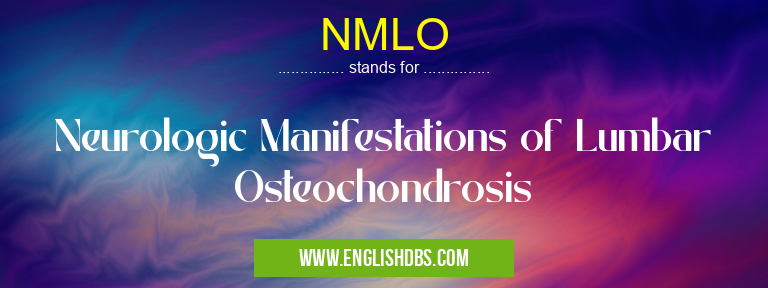What does NMLO mean in NEUROLOGY
NMLO (Neurologic Manifestations of Lumbar Osteochondrosis) refers to a group of neurological symptoms that result from the degeneration of intervertebral discs in the lumbar (lower) spine. This condition, also known as lumbar disc disease, occurs when the soft, gelatinous center of the disc pushes out through the tough outer layer, causing pressure on nearby nerves and structures.

NMLO meaning in Neurology in Medical
NMLO mostly used in an acronym Neurology in Category Medical that means Neurologic Manifestations of Lumbar Osteochondrosis
Shorthand: NMLO,
Full Form: Neurologic Manifestations of Lumbar Osteochondrosis
For more information of "Neurologic Manifestations of Lumbar Osteochondrosis", see the section below.
Symptoms
The symptoms of NMLO can vary depending on the severity of disc degeneration and the location of the affected nerve. Common symptoms include:
- Back pain
- Leg pain (sciatica)
- Numbness or tingling in the legs or feet
- Weakness in the legs or feet
- Difficulty with balance or walking
Causes
NMLO is primarily caused by the aging process, which leads to the breakdown of intervertebral discs. Other contributing factors can include:
- Heavy lifting or manual labor
- Obesity
- Poor posture
- Trauma or injury to the spine
Diagnosis
Diagnosis of NMLO involves a physical examination and a review of symptoms. Imaging tests, such as X-rays, MRI, or CT scans, can help visualize the affected discs and identify nerve compression.
Treatment
Treatment for NMLO depends on the severity of symptoms and the underlying cause. Conservative treatments, such as physical therapy, medication, and activity modification, can often relieve pain and improve function. In more severe cases, surgery may be necessary to remove the herniated disc or decompress the affected nerve.
Essential Questions and Answers on Neurologic Manifestations of Lumbar Osteochondrosis in "MEDICAL»NEUROLOGY"
What is Neurologic Manifestations of Lumbar Osteochondrosis (NMLO)?
NMLO is a condition characterized by nerve root compression due to degeneration of the lumbar spine's intervertebral discs and surrounding structures. This nerve compression can lead to a variety of neurological symptoms.
What are the common symptoms of NMLO?
Symptoms of NMLO can include lower back pain, muscle weakness or numbness in the legs, tingling or burning sensations, difficulty walking or standing, and incontinence.
What causes NMLO?
NMLO is primarily caused by the natural aging process, which leads to the degeneration of the intervertebral discs. Other contributing factors include obesity, smoking, heavy lifting, and repetitive bending or twisting motions.
How is NMLO diagnosed?
Diagnosis of NMLO involves a physical examination, medical history review, and imaging tests such as X-rays, MRI, or CT scans. Electrophysiological studies may also be used to assess nerve function.
What are the treatment options for NMLO?
Treatment options for NMLO vary depending on the severity of the condition. Conservative treatments include pain relievers, physical therapy, chiropractic adjustments, and acupuncture. Surgery may be necessary in severe cases where nerve damage is significant.
How can NMLO be prevented?
While aging is a primary risk factor for NMLO, certain lifestyle choices can help reduce the risk. Maintaining a healthy weight, engaging in regular exercise, and practicing proper posture and body mechanics can contribute to spinal health.
Final Words: NMLO is a common condition that can cause significant pain and disability. Early diagnosis and appropriate treatment can help manage symptoms, prevent further nerve damage, and improve quality of life.
